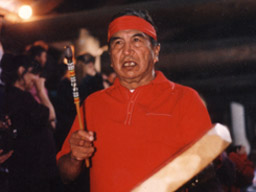ti-at-mus – Raymond Moses
Since he was a boy, Raymond Moses was taught the importance of the old teachings. He remembered the culture, the language, and the oral storytelling traditions of the Snohomish people. Throughout his life, no matter what he faced, he never lost sight of those values and traditional ways. In fact, leaving those teachings for future generations became his legacy.
 Raymond Moses was born February 20, 1930. He carried the ancestral name of his father and grandfather, ti-at-mus. His father, Walter Moses, was of the Suiattle Tribe and his mother, Marya Jones, was of the Snohomish. His grandparents were Billy and Julie Moses of the Suiattle, and Bill and Nancy Jones of the Snohomish. Nancy Jones, formerly Nancy Boomhouse, was the last of the true Snohomish, as ti-at-mus would always say. He was proud of his heritage and what it meant, understanding that traditional identity was tied to the grandparents. Whenever he would speak, he would bring out information about families, always urging his people to learn it for themselves, to know who they are and where they come from.
Raymond Moses was born February 20, 1930. He carried the ancestral name of his father and grandfather, ti-at-mus. His father, Walter Moses, was of the Suiattle Tribe and his mother, Marya Jones, was of the Snohomish. His grandparents were Billy and Julie Moses of the Suiattle, and Bill and Nancy Jones of the Snohomish. Nancy Jones, formerly Nancy Boomhouse, was the last of the true Snohomish, as ti-at-mus would always say. He was proud of his heritage and what it meant, understanding that traditional identity was tied to the grandparents. Whenever he would speak, he would bring out information about families, always urging his people to learn it for themselves, to know who they are and where they come from.
His pride in traditional heritage and identity was matched only by his passion for his language and the x̌əč̓usadad, the traditional values and teachings held there within.
ti-at-mus was pained to see the peril his language was in. “My deep concern for my Indian people is that we’re losing our language when each old-timer dies.”
The x̌əč̓usadad held by the elders was vast and complete. ti-at-mus was steadfast in the teaching of listening to the elders, because they are telling you something; whether it be history, a teaching, a story, or just to offer guidance and encouragement. He stressed most often the need to preserve and protect the history and the values in the oral traditions.
Listening was only part of it. ti-at-mus, like many elders, would speak of a time when the ones listening would become the teachers. A huge responsibility. Not only for the sake of the families, but for all who belong to these traditions. He said, “We must preserve what we have, what is left, with respect.” To him, that meant carrying the traditions forward without changing them to suit modern times.
“You were to pass on history. You weren’t to change words. When you tell legends, stories to the children, they would all listen because there was a reason behind each legend or a moral. They’d tell you stories, your relay that to your people. Nowadays children don’t listen, or don’t care.”
The struggles to maintain our language are tied to losing the children to the fast modern world, as well as the trauma of the elders. In spite of these struggles, ti-at-mus always encouraged his people to learn from the elders.
“The latest excuse I hear is ‘I went to the government school.’ But you can learn…”
He would bring out the teachings of the elders and the values they held. The more words you knew, the better you could communicate, these are the traits of high-class people. These are the traits of the sduhubš people. Language, history, and traditions are all part of the culture. Even as they have been removed from the people, because of the work of ti-at-mus and others like him, we can learn the dignity of these things.
ti-at-mus truly believed in Indian traditions. He truly believed for his people that learning and living the traditions would carry them through the hard times and make them stronger, as they did for him.
